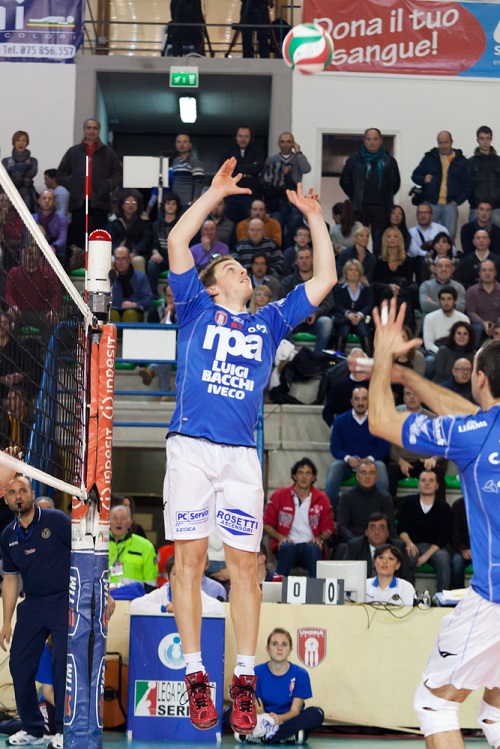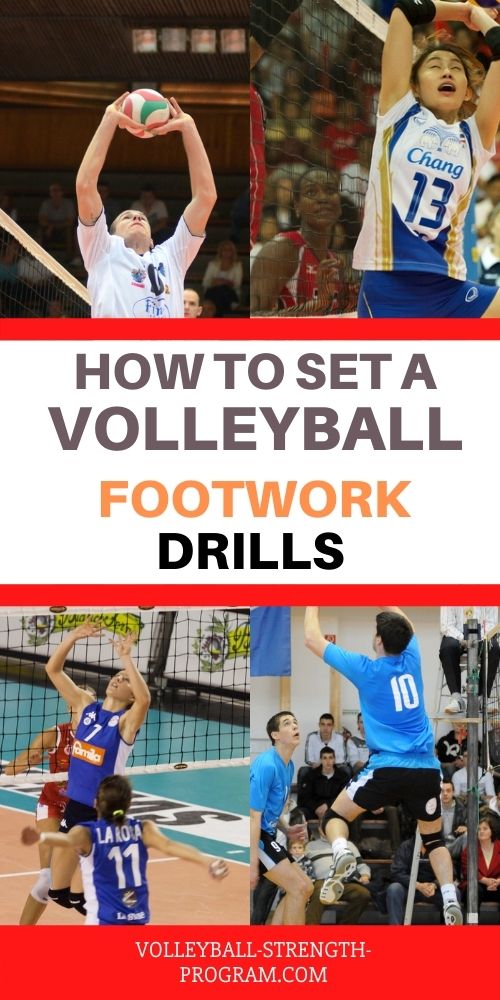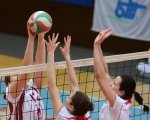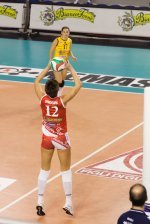Setter Training Tips
Setter training is necessary if you want to become a great setter.
Do you have aspirations for setting in college? If so, you definitely need to learn the correct techniques for setting. All the best setters have one thing in common... they all have learned specific skills for the setting position.
Basics of Setter Training
The goal of setting is to accurately and consistently direct the ball to a location where a hitter can spike the ball over the net using an approach jump with a full arm swing.
Setting occurs during a teams 2nd team contact. The setter is basically quarterbacking the teams offense.
There are great physical and mental qualities important to setting. The setters ability to handle the second ball, control its height and speed, and consistently direct the ball to teammates is essential to a teams success when competing at a high level.
This is why the setting position is usually considered the most important position on the team.
Important elements of setting....
- Quick to the ball
- Receiving the ball in a vertical position
- Setting the ball accurately to various locations
The setter must be able to take the ball above and in front then release it without the ball coming to rest or spinning (double contact).

Learning to Set
The first thing the setter needs to learn is the position of the hands. The setter should focus on taking the ball in the same position with every set.
Important tips for hand position...
- Focus on a consistent start and finish hand position
- Have all 10 fingers contact the ball
- The hands should be symmetrical on the ball, meaning, hands contact the ball evenly
- Hands are positioned above the head, not too low or too far out in front
- Take the ball high and keep the hands high when you set
- Focus more on hand action and less on arm movement
Examples of Incorrect Technique
Sometimes it helps to understand how to set correctly by understanding the common setter training mistakes. Here's a list of some of the most common mistakes.
- Hands aren't open to receive the ball. The start position is critical. If you have trouble setting the ball, be sure to check the hand position at pre-contact.
- Hands aren't facing the ball. Don't make the mistake of having the hands not face the ball.
- Set the ball by contacting with the finger tips, not the pads of the hands.
- Don't have the thumbs contact the ball first. Check the position of the thumbs at pre-contact.
- The finish position should be behind the ball, don't have the hands flailing out to the sides.
- Keep the ball high when you set. Don't make the mistake of bending the elbows a lot thinking that you will set the ball farther if you can use more elbow bend.
- Don't use a deep dish setting motion. For 6 vs 6 competition, we want the ball to get out of the hands fast. This style of setting will make it more difficult for the opponent to read what is happening. So, be sure to not get in the habit of lowering the ball down in front of the face. The hands should stay high. Focus on fast hands. Think of an overhead throwing motion with very little elbow bend. This is how the setter should set the ball.
- Contact the ball more behind the head for setting the ball back. You don't want to contact the ball too far in front for setting the ball back. A way you can avoid this is by moving quickly forward through the ball as you set. Focus on quick hands to fire the ball back out of the hands.
Setter Training Footwork
In my opinion, footwork for the setter is the most important footwork of any player on the team.
To be a great setter, you need to learn the correct movements. Footwork is less important for a perfect passed ball. However, most passes in volleyball aren't directly to the setter. How efficiently the setter moves to the ball will determine how well the setter is able to get into the correct position to make the play. Positioning is everything and having consistent footwork allows the setter to get into the correct position.
Basic Movements...
- Left-Right Finish. Finish moving left-right as you set the ball. This is the basic movement pattern. This position allows the setter to be open to the ball as they are making the set.
- Sets off a single leg. Most of the time the setter will need to make athletic movements when getting in position to set. Many movements are made off of a single foot. There are movements that finish on the left foot and also on the right foot.
- Jump setting. Jump setting is an advanced skill that all serious setters should learn. It may take awhile to get comfortable with the jump set, but often a setter will find it easier to set off a jump. Jump setting has many advantages such as 1) making it tougher for the opponent to anticipate, 2) the setter needs to jump to get to a tight ball at the net, 3) a front row setter is a threat to attack the second ball.
Drills for Setter Training
- Rapid Fire Wall Setting. Focus on getting the ball out of the hands as fast as possible. Emphasize a consistent before and after hand setting position. Maintain a high hand position throughout the duration of the drill. Right foot is slightly forward for each repetition.
- Target Setting Drills. Set to a target to get immediate feedback on the location of the set. Do both self-toss drills and drills that involve a coach tossing the ball. Eventually advance to a ball that's passed from a teammate.
- Along-the-Net Movement Series. Test the setters range moving to the areas along the net.
- Off-the-Net Movement Series. Test your setter to see how well they move. If the setter struggles coming off the net to set, then focus more on this movement in your setter training.
If you enjoyed these tips and would like to keep it close to you at any time, just save this pin to your Pinterest Volleyball Training Board.
Volleyball › Volleyball Techniques › Setter Training
ACCESS MY STRENGTH SECRETS




